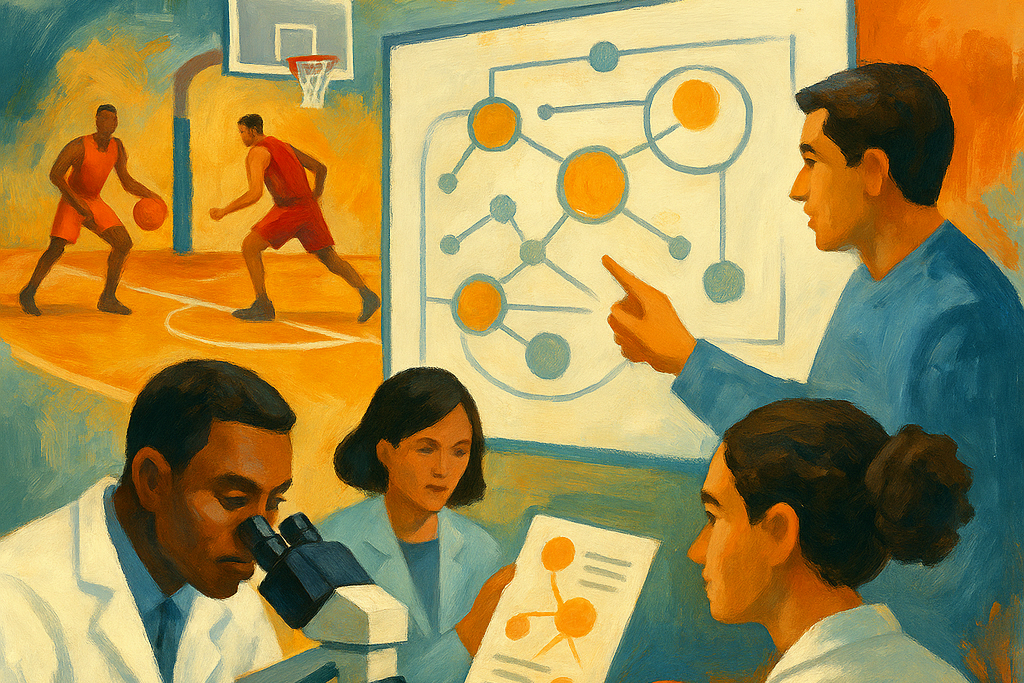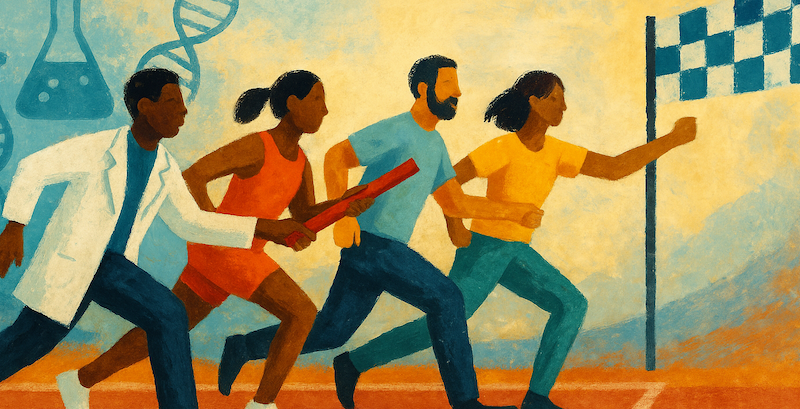Written by Tyren Lucas - July 25, 2025
In the world of research, collaboration across disciplines is not a novel idea for achieving scientific discovery. It is the norm. Research projects are very complex, so scientific teams must be equipped with an expert group of interdisciplinary research professionals who are focused on a shared vision with common goals. When they work well, interdisciplinary collaborations are fertile ground for innovation. One might ask, “What does successful interdisciplinary collaboration look like?” To break this down, let’s step away from the lab bench and see interdisciplinary teamwork through a competitive sports lens.The Dream Team: Building the Right Roster
 Building a research team is not about putting together a group of people who agree on everything or work in the same department. Imagine a basketball team. There are 5 players with different roles and skills that come together to achieve a common goal. A guard may lead the team, but they need a forward and a center to share the ball, score, play defense, and most of all, win games. This is no different than a scientific team on a research project. For example, think about a randomized controlled trial of a physical activity intervention. A principal investigator (PI) leading that study needs a team of interdisciplinary specialists to perform the study. The team may have a nutritionist, physical therapist, registered nurse, community health specialist, research coordinator, and statistician on that team. Everyone brings unique skills and expertise that complement each other and contributes to the overall success of performing the study. The PI may serve as the coach and general manager, yet building a formidable roster of collaborators from multiple disciplines to fulfill key expertise needs is essential for team success.
Building a research team is not about putting together a group of people who agree on everything or work in the same department. Imagine a basketball team. There are 5 players with different roles and skills that come together to achieve a common goal. A guard may lead the team, but they need a forward and a center to share the ball, score, play defense, and most of all, win games. This is no different than a scientific team on a research project. For example, think about a randomized controlled trial of a physical activity intervention. A principal investigator (PI) leading that study needs a team of interdisciplinary specialists to perform the study. The team may have a nutritionist, physical therapist, registered nurse, community health specialist, research coordinator, and statistician on that team. Everyone brings unique skills and expertise that complement each other and contributes to the overall success of performing the study. The PI may serve as the coach and general manager, yet building a formidable roster of collaborators from multiple disciplines to fulfill key expertise needs is essential for team success.Coordination and Execution is Key: Success Starts with “The Game Plan”
Interdisciplinary teams do not require everyone to share the same ideas or disciplinary background. They do need to share common goals and objectives when coming together for a research project. Another component of bringing the interdisciplinary team together is establishing a shared language so communication is clear for all involved, preventing messages from getting lost in translation. For example, bringing research professionals from multiple disciplines involves individuals speaking in discipline-specific terms. A cardiologist will talk about topics differently from a biostatistician. This can cause a communication barrier. To overcome this issue, establish a “game plan” early where you define the goals and objectives, clarify everyone’s roles, develop processes, and create a shared language by defining terminology, so interdisciplinary teams can position themselves for success.Practice Invigorates Advancement: It Doesn’t Have to Make Perfect
Working within an interdisciplinary team is as much about learning as it is about working together as a cohesive unit. The beauty of interdisciplinary teams is that everyone does not know everything, but everyone can learn from each other. Immersing oneself in other disciplines is not about becoming an expert or master of all things but rather developing an appreciation for other “disciplinary languages” to engage meaningfully and comfortably with their collaborators. Through repeated interaction, interdisciplinary teams will develop their “team muscle memory” where they can collaborate efficiently and effectively. This trust and understanding often leads to breakthroughs that would have been nearly impossible to achieve in silos. Practice is not about achieving perfection; it is about engaging in activities that help teams improve.The Long Game: Measuring Success Is Not Always About “Winning”
To measure interdisciplinary team success, it is not always about wins, but more about the process of getting to their goal. Team cohesion, overcoming adversity, achieving knowledge gain, advancing ideas, and exhibiting growth are qualities of success. It is not always about “winning the championship” and getting the accolades and recognition. For example, when you see championship teams in sports come together for a celebration of their achievements years after they are done with the sport, the long-term impact of what they achieved and the lifetime of memories, impact to their sport, and lifelong connections they made will outlive their singular accomplishment. To put that in context, interdisciplinary research teams should be evaluated not just by funding success or publications, but also the long-term impact of their collaboration, the creation of innovative ideas and processes, and most of all, their impact on the scientific community and the world. An interdisciplinary team may achieve their goal of crossing the boundaries of scientific discovery with a new clinical or public health intervention, but the lasting impact of their project on the world and the long-term connections from their collaboration often yield benefits that outlast the initial project. Interdisciplinary collaborations leave a legacy that inspires future scientific research discoveries.Conclusion: The Race Still Continues Past the Finish Line
 Interdisciplinary research is not a solo sport. The race to discovery is a relay where different people carry the baton along the way to the finish line. Every person carrying the baton is integral to the progress of their research and the success of their team. When interdisciplinary research teams combine the strengths across fields and collaborate with a solid game plan, great things can happen. The product of those interdisciplinary collaborations can overcome barriers in research and accelerate scientific discovery. So, whether you're the coach or a role player on an interdisciplinary research project, it is a team game, and the best wins come when they play together.
Interdisciplinary research is not a solo sport. The race to discovery is a relay where different people carry the baton along the way to the finish line. Every person carrying the baton is integral to the progress of their research and the success of their team. When interdisciplinary research teams combine the strengths across fields and collaborate with a solid game plan, great things can happen. The product of those interdisciplinary collaborations can overcome barriers in research and accelerate scientific discovery. So, whether you're the coach or a role player on an interdisciplinary research project, it is a team game, and the best wins come when they play together.Subscribe to the weekly CCTS Digest to stay updated on this on-going campaign, CCTS In Focus: Translational Workforce Development, as well as upcoming CCTS events.